Microsoft Surface Pro Review
by Anand Lal Shimpi on February 5, 2013 9:00 PM ESTDisplay: Awesome if Calibrated
Surface RT used a 10.6-inch 1366 x 768 display, for Surface Pro Microsoft integrated a full 1920 x 1080 panel of the same size. The increase in resolution is appreciable and you definitely notice it when switching between the two Surface models. Pixel density isn’t class leading, but it’s at least in the right range. On the desktop, Microsoft enables 150% DPI scaling by default which makes everything legible but still a bit odd in applications that don't deal well with fractional DPI scaling. Ideally I would've liked to have seen a clean doubling to avoid this mess.
The higher res display just makes everything sharper in the modern UI, and the 150% DPI scaling in desktop mode makes everything big enough where the higher res isn't a problem there. It's only in those desktop applications that don't properly implement Windows DPI scaling where the higher resolution is a hindrance. I actually ran into this problem using Chrome on the desktop, where my taps wouldn't always map to the right parts of the application (not to mention that Chrome in DPI scaled Windows looks terrible). Thankfully there is always the pen...
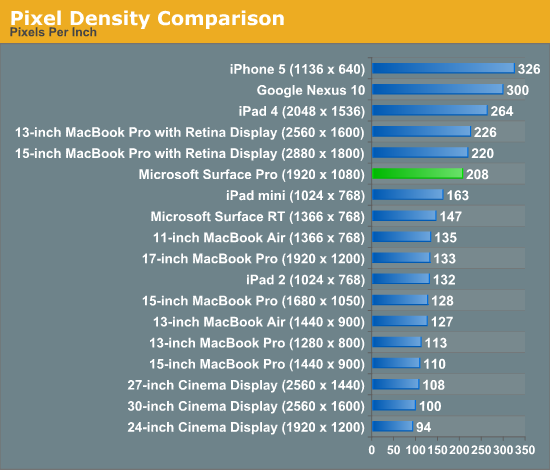
Once again Microsoft doesn’t do any substantial color calibration at the factory, but unlike on Surface RT you can run your own Windows display calibration software on Surface Pro to improve color accuracy if you have the right equipment.
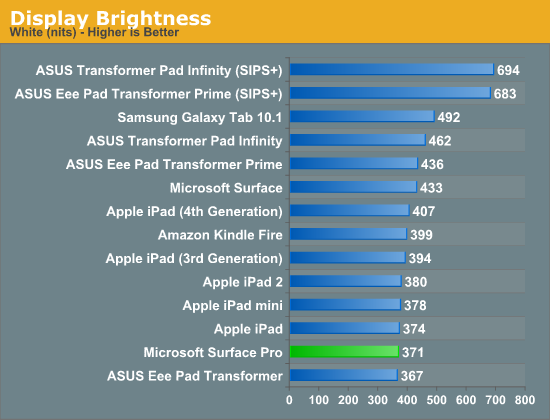
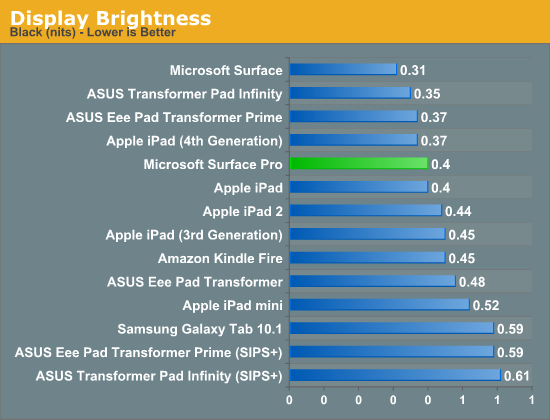
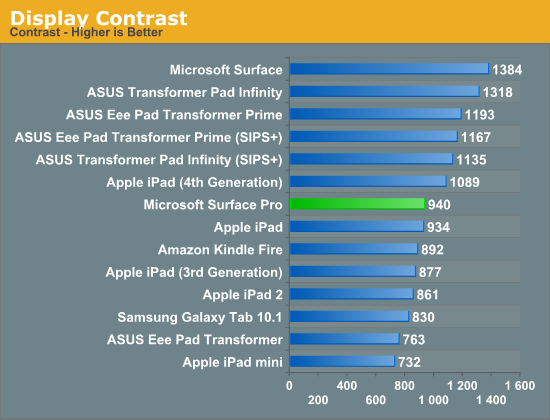
Out of the box my Surface Pro sample had an unusually high white point (~7500K), which negatively impacted its grayscale accuracy. To evaluate color accuracy I turned to our own Chris Heinonen's CalMAN smartphone/tablet workflow. Color accuracy is near identical to Surface RT, which is to say that it’s ok compared to PC notebooks from a couple of years ago but still far behind what you get out of the box from Apple.
Given that the majority of users don’t do any color calibration on their PCs, this becomes a real problem for consumer perception if your tablet doesn’t ship with accurate colors by default.
To see what the panel is capable of I ran it through our standard PC display calibration routine (which I can do since it’s running Windows 8 and is effectively a PC). I then re-ran it through our CalMAN smartphone/tablet workflow and ended up with much more pleasing results. While the display still lagged behind the iPad in one of the tests, it bested Apple’s Retina Display in the other two color accuracy benchmarks.
We'll start off by looking at the calibrated white point for these tablets. What you're looking for here is a number close to 6500K:
The next three charts look at accuracy represented as a difference between various source colors and what's reproduced on the display. The results are presented as average dE2000, with lower numbers being better.
First up is Grayscale performance, here we're looking at the accuracy of black, white and 19 shades of gray spread in between the two extremes:
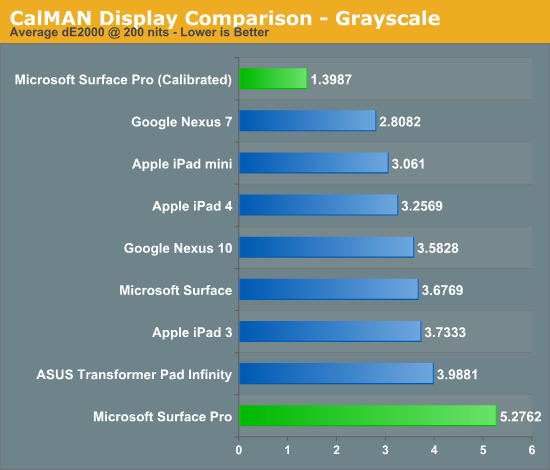
Out of the box grayscale performance is abysmal on Surface Pro. Calibrated accuracy, on the other hand, is just awesome.
First in our color accuracy tests is a saturation sweep. Here we're looking at 20%, 40%, 60%, 80% and 100% saturations of red, blue, green, magenta, yellow and cyan.
Our saturation sweep is the only test where even a calibrated Surface Pro can't match the iPad, it does do a lot better than Surface Pro without any color calibration however. Out of the box Surface Pro is considerably worse than any Apple tablet.
Gamut CIE Chart

Saturation CIE Chart
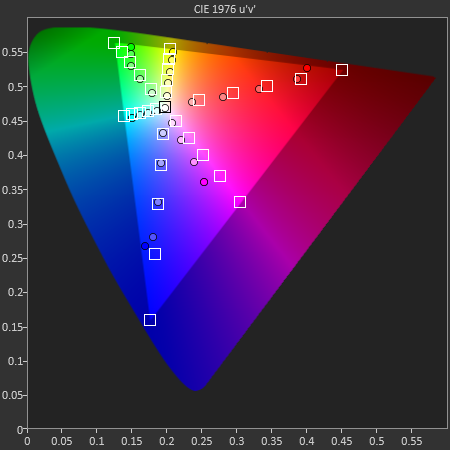
For our final accuracy test we're looking at the difference between a Gretag Macbeth colorchecker chart and the rendered swatches on these displays. Once again, lower numbers are better.
Out of the box Surface Pro and Surface RT are near identical here, and similar to the Nexus 10. With a good suite of calibration tools and supported hardware under Windows 8, Surface Pro has the potential to easily outperform the iPad if given the opportunity.
GMB Color Checker
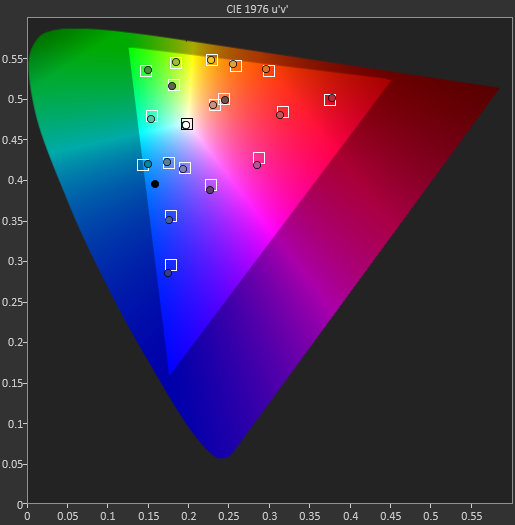
Surface Pro’s panel has real potential, it just needs a calibration pass - which is honestly something Microsoft should be doing these days, not the end user.
Mini DisplayPort but No Thunderbolt
Surface RT featured a single video output in the form of a micro HDMI port. Surface Pro adopts a mini DisplayPort output instead, and will have adapters to enable DVI and HDMI support.
The miniDP output immediately activates as soon as you plug a display into it. I sometimes had issues with display resolutions being set sub optimally, but generally speaking the process was as plug and play as you can get.
I did notice some visual tearing on the Surface Pro display when connected to an external HDMI monitor, similar to what I saw with Surface RT but not nearly as bad. I’m beginning to think something is a bit wonky with Windows 8’s multi-monitor support. What’s interesting is I didn’t see the issue on all displays, which is more than I can say for Surface RT. Update: It looks like this is hardware related. Even if the internal and external panels have the same refresh rate, Intel's HD 4000 won't guarantee that the refreshes will happen at the same time - which is why we see tearing. The tearing should only be present in clone mode, not extended desktop (I'll verify this shortly). It seems like Tegra 3 is worse in this regard, which is why the issue was so much more prevalent on Surface RT. I need to check other Ivy Bridge platforms and under OS X to see if the problem is as prevalent there as well.
The only disappointment here is Microsoft opted against integrating Thunderbolt into Surface Pro. I feel like Thunderbolt would’ve made a ton of sense in a device like Surface Pro, enabling one cable connection to both an external display and high-speed external storage. Given that Thunderbolt adoption remains fairly limited in the PC space I don’t think this is a huge loss for most of Microsoft’s target customer base, but I do feel like it’d be a good way of future proofing the device. The alternative that Surface Pro offers is the combination of miniDP and USB 3.0, which realistically speaking is probably good enough for most users. From a cost of integration standpoint vs. the number of users who would pay for it, it probably didn’t make sense for Microsoft to include Thunderbolt in Surface Pro, but that doesn’t change the fact that I wish it was there. It’d be nice for Apple not to be the only company really pushing Thunderbolt.
Camera Quality
Surface Pro, like Surface RT before it, features two integrated 720p cameras with no flash. Admittedly I didn't spend a ton of time taking photos with Surface Pro but imaging quality is just really bad compared to what you'll get out of an iPad 4. The results are borderline ok for use on the web but that's pretty much it, and forget about decent low light performance.


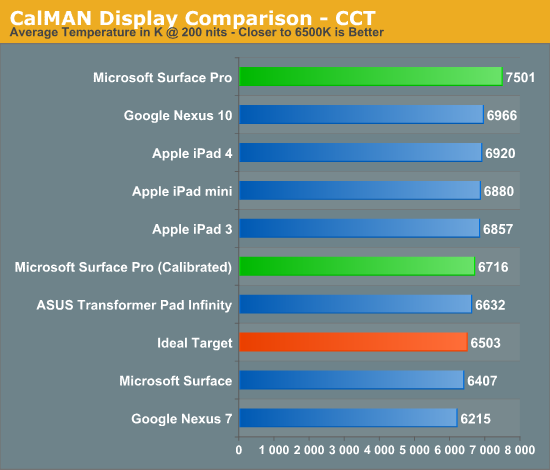
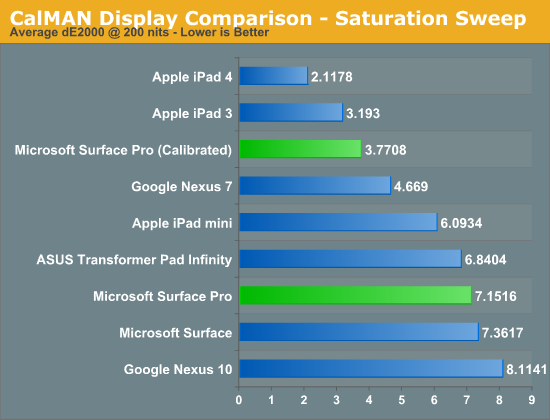
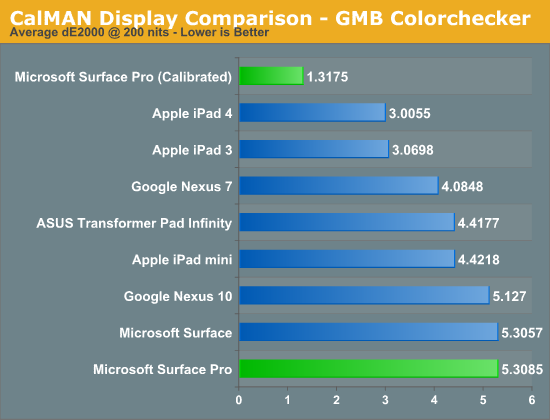










228 Comments
View All Comments
kyuu - Friday, February 8, 2013 - link
I'm looking to get a mobile device with part of my tax return. I have zero interest in an iOS or Android tablet. What I'm looking at currently:1) Vizio's Hondo-based Tablet PC that was shown at CES.
2) Vizio's 2nd gen thin+lights, 14" model with touch screen and AMD A10
So basically, an ultrabook (thin+light) or a tablet are the only mobile devices I'm interested in. A normal laptop is too heavy and bulky for me to reguarly take with me out of the house. The Surface Pro would be in consideration, but the price is a little higher than I'm willing to spend (and should *really* include one of the covers).
atl - Wednesday, February 6, 2013 - link
42W 2 cell battery means 2 x 6 amps Li-ion cells (probably cut at 90% to increase cycles).As Li-ion charges from 0% to 70% at 1C, it requires 6amp charger.
Supplied charger just doubles the fast-charge period
kawatwo - Thursday, February 7, 2013 - link
Would like to see some Win 8 tablets with Core I3 and weight under 1.5 pounds. 2 pounds is a bit heavy for a tablet. Needs to include the Type keyboard as well. But overall what an awesome device. I'm sure other PC makers will get it right in the not real distant future.jeffkibuule - Friday, February 8, 2013 - link
Acer will have a newer version of the W700 with a 7W SDP Ivy Bridge chip that is 20% thinner than their current model (around 8mm), so it's certainly possible.phillyry - Saturday, February 16, 2013 - link
Graphics would blow on an i3 and make the touch based interface borderline unusable.Sabresiberian - Thursday, February 7, 2013 - link
I think Microsoft got into building their own hardware here because they felt forced to; no one was building the kind of quality device they wanted. I think Nokia and HTC need to step their games up too if they don't want a Microsoft phone to come along and take their business away (or relegate it to the cheap seats). I like this approach, and hope they do kick the phone industry on the pants, because none of them are what I'd really call "good". (I'm talking ALL smart phones, not just Win 8 phones - phones that really don't take much of a back seat to anything else on the market, overall.)THE one thing that kills the Surface for me is the 16:9 screen. that's okay for a tablet I suppose, but the Surface isn't about being "okay", and I think it's a slam in the face of a real quality experience. It puts the iPad out of the picture in every other way (in my opinion), but in this way, the iPad still pretty much kills everyone else.
Netscorer - Thursday, February 7, 2013 - link
Nobody else is building these because there is not enough demand. Microsoft can afford to chuck up all the costs that gone into Surface as marketing for Windows 8 OS, but if you are a typical PC manufacturer who operates on razor thin margins, you won't be able to afford to do what it takes to create an iPad killer. Add to this that neither Intel, nor Microsoft are giving you much of a slack on prices for core and Windows and that market for $1000+ laptops is already very small to begin with and you get the picture.SilthDraeth - Thursday, February 7, 2013 - link
I know it was a windows 7 tablet, but it to runs on a core i5 and 2gb of RAM. Have you guys never bench marked it, to include it in the graphs, in comparison to the newest?Silma - Thursday, February 7, 2013 - link
While it is perfectly clear to me that with a much bigger processor power consuption will be bigger than a way slower arm, hence it is to be expected that ultrabooks/surfaces can't have the same battery life as an iPad or nexus tablet, I don't understand the extreme différences seen in video playback benchmarks.On this benchmark I would of course expect Windows 8 offering to use a little more power than on an ios / android tablet due to the overhead of a bigger os, but here the différences are huge.
Here I think Microsoft and Intel could optimize greatly the power usage for 720p and 1080p mp4 playback.
andrewaggb - Thursday, February 7, 2013 - link
Agreed.